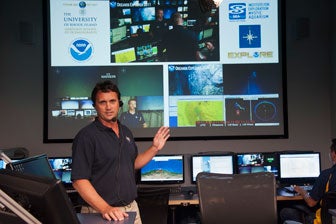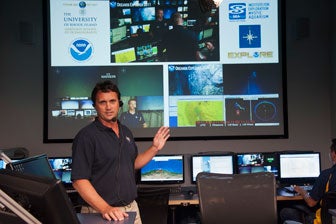 KINGSTON, R.I., April 26, 2016—Federal investigators announced today that they found the “black box” that could reveal why the El Faro cargo ship sank off the Bahamas in a hurricane last fall—and that the University of Rhode Island played a key role in the discovery.
KINGSTON, R.I., April 26, 2016—Federal investigators announced today that they found the “black box” that could reveal why the El Faro cargo ship sank off the Bahamas in a hurricane last fall—and that the University of Rhode Island played a key role in the discovery.
URI’s internationally acclaimed Inner Space Center at the Graduate School of Oceanography provided telepresence technology—and its expertise—to assist with the search.
Dwight F. Coleman, center director, worked closely with the National Transportation Safety Board and the Woods Hole Oceanographic Institution to install telepresence technology on the research vessel Atlantis, the Woods Hole ship that conducted the search.
“Finding an object about the size of a basketball almost 3 miles under the surface of the sea is a remarkable achievement,” said NTSB Chairman Christopher A. Hart. “It would not have been possible without the information gained during the first survey of the wreckage and the equipment and support provided by Woods Hole Oceanographic Institution, the National Science Foundation, the U.S. Coast Guard, the U.S. Navy, the University of Rhode Island, and the many other partners involved in this effort.”
Coleman said URI’s “cutting-edge telepresence technology helped provide critical clues to investigators to determine why the El Faro sank. There’s some mystery as to what happened, so finding the voyage data recorder could reveal key details about the critical moments before the sinking.”
The 790-foot cargo ship, loaded with shipping containers and cars, sank Oct. 1 during Hurricane Joaquin on its way from Jacksonville, Fla., to San Juan, Puerto Rico. All 33 crew members died, making it one of the worst disasters involving an American cargo vessel in decades.
The ship was found a month later in about 15,000 feet of water, but the voyage data recorder—a “black box” type device—that could provide clues was never located.
So far, video has shown that the two upper decks, including the navigation bridge, had separated from the El Faro’s hull and were about a half mile away on the ocean floor.
On April 16 and 17, Coleman installed ship-to-shore telecommunications equipment on the Atlantis, and he supervised an upgrade to the ship’s satellite-tracking antenna to allow high-definition video broadcasts to stream ashore.
He also helped install telecommunications equipment at NTSB’s headquarters in Washington, D.C. to receive the broadcasts and enable two-way communication.
“My efforts allowed NTSB investigators and other experts on shore to participate in the day-to-day search activities and identify the voyage data recorder on the seafloor,” he said.
The data recorder is crucial to the investigation: It should have recorded audio from the bridge and information about the ship’s speed and course.
Woods Hole, partnering with NTSB, searched a 13.5-square-mile debris area in the Atlantic Ocean for the last few days or so. The team used an autonomous underwater vehicle—known as Sentry—to collect sonar data and high-resolution photographs of the debris.
URI’s telepresence technology provides a better way to transfer the images to on-shore investigators who can identify objects for recovery or closer inspection.
“We hope our technology can be used in future investigations—other shipping accidents or plane disappearances in the ocean,” said Coleman. “We hope to use the technology to accelerate search and recovery operations and make them more affordable. If you can find what you’re looking for faster, you’re saving expense and solving the case sooner.”
The Inner Space Center, located on URI’s Narragansett Bay campus, was developed through the efforts of marine explorer and URI Professor Robert Ballard. Largely funded by a bond issue approved by Rhode Island voters in 2004, the facility opened in 2010.
The center’s mission is to expand participation in seagoing oceanographic research in real time by connecting scientists on ships with their colleagues on shore. It’s modeled after Mission Control at the Johnson Space Center in Houston.
“What we do at our center is similar to what NASA does to communicate with astronauts in space,” said Coleman. “Thanks to satellites and advanced Internet technologies, we can interact with scientists live onboard and participate in decision making in real time.”
The center—the only one of its kind in the world for ocean research—routinely supports the research missions of the R/V Endeavor, a URI research vessel, the missions of the exploration vessel Nautilus—Robert Ballard’s research ship—and the Okeanos Explorer, which is based at Quonset Point, R.I., and owned and operated by the National Oceanic and Atmospheric Administration.
For more information about the center, visit Inner Space Center.
Pictured above: Dwight F. Coleman, director of the University of Rhode Island’s Inner Space Center at the Graduate School of Oceanography on the Narragansett Bay campus. Photo courtesy of URI.

